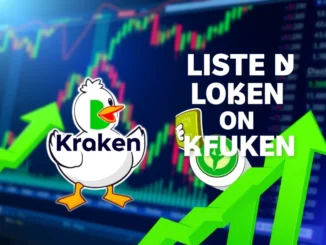
Hold onto your hats, crypto enthusiasts! The stablecoin giant, Tether, has just dropped another billion USDT into the digital ocean, specifically on the Tron network. According to Onchain Lens, this latest minting spree brings the total USDT issued in 2025 on Tron to a staggering $6 billion. That’s a whole lot of stablecoins flooding the market! But what does this mean for you, the everyday crypto user, and the broader market? Let’s dive into this fascinating development and unpack what’s really going on.
Why the Buzz Around Tether USDT Minting?
First things first, why is everyone making such a fuss about Tether USDT minting? Well, USDT is the king of stablecoins. Pegged to the US dollar, it’s designed to provide a safe haven from the volatility often seen in other cryptocurrencies like Bitcoin and Ethereum. When Tether mints more USDT, it increases the overall supply of this crucial stablecoin in the crypto ecosystem. Think of it like this: USDT is often used as fuel for trading and liquidity in the crypto markets. More fuel could mean more action!
But here’s the million-dollar question (or should we say, billion-dollar question?): Why is Tether minting so much USDT, especially on the Tron Network? Let’s break down the key factors:
- Surging Demand: The most straightforward reason is increased demand for USDT. Traders and investors might be seeking stablecoins to park their funds, enter new positions, or facilitate transactions. A surge in demand often precedes or accompanies market rallies.
- Tron Network’s Popularity: Tron has become a favorite for USDT transactions due to its generally lower fees and faster transaction speeds compared to some other blockchains like Ethereum (though Ethereum Layer 2 solutions are changing this landscape). This makes Tron an attractive option for moving USDT around, especially for high-volume users.
- Market Sentiment: Massive stablecoin minting can sometimes be interpreted as a bullish signal. It suggests that there’s capital ready and waiting to be deployed in the crypto market. However, it’s crucial to remember that correlation doesn’t equal causation.
Tron Network: The Go-To Blockchain for USDT?
So, why is Tron Network consistently seeing such large USDT mints? It’s not just a coincidence. Tron has strategically positioned itself as a hub for stablecoin activity. Here’s why Tron and USDT are such a popular pairing:
| Feature | Tron Network | Ethereum Network (Mainnet) |
|---|---|---|
| Transaction Fees | Significantly Lower | Higher, can fluctuate |
| Transaction Speed | Faster Confirmation Times | Slower Confirmation Times, especially during congestion |
| USDT Availability | Widely supported and readily available | Also widely supported, but fees can be a barrier for smaller transactions |
| Network Focus | Geared towards high-throughput and lower cost transactions, appealing to stablecoin transfers | Broader ecosystem, but historically higher costs for simple transfers |
As you can see, for users primarily concerned with moving USDT efficiently and affordably, Tron often presents a compelling case. This has led to a significant portion of the USDT supply residing on the Tron blockchain.
Decoding Stablecoin Minting: Bullish or Bearish Signals?
Now for the burning question: Is this massive stablecoin minting a good or bad thing for the crypto market? The answer, as with most things in crypto, is nuanced. It can be interpreted in several ways:
- Potential Bullish Indicator: Increased USDT supply can be a precursor to market rallies. Traders often move funds into stablecoins before deploying them into other cryptocurrencies. A large mint could suggest that investors are preparing for increased market activity and potential price appreciation.
- Liquidity Boost: More USDT means increased liquidity within the crypto ecosystem. This can make trading smoother, reduce slippage, and facilitate larger transactions. Healthy liquidity is generally seen as positive for market stability and growth.
- Demand for Stablecoins: The minting clearly indicates a strong and sustained demand for stablecoins, particularly USDT. This highlights the crucial role stablecoins play in the crypto market infrastructure.
- Not Always Bullish: It’s essential to avoid jumping to conclusions. While increased USDT supply *can* be bullish, it’s not a guaranteed indicator. Sometimes, large mints can also occur during periods of uncertainty, as investors move assets into stablecoins to reduce risk.
Actionable Insight: Don’t solely rely on USDT minting as a predictor of market direction. Consider it as one piece of the puzzle. Look at other indicators like trading volume, on-chain metrics, macroeconomic factors, and overall market sentiment for a more comprehensive picture.
The Power of Blockchain Technology in Stablecoin Operations
This whole USDT minting story underscores the power and efficiency of blockchain technology. Imagine the traditional financial system trying to issue and distribute billions of dollars with the speed and transparency that Tether achieves on the blockchain. It would be a much slower, more cumbersome, and less transparent process.
Benefits of Blockchain for Stablecoins:
- Transparency: Blockchain transactions are publicly recorded and auditable. While Tether’s reserves have been a topic of debate in the past, the on-chain movements of USDT are transparent.
- Efficiency: Minting and transferring USDT on blockchains like Tron is incredibly fast and cost-effective compared to traditional banking systems.
- Accessibility: Stablecoins on blockchain networks are accessible to anyone with an internet connection and a crypto wallet, democratizing access to USD-pegged assets.
- Programmability: Blockchain technology allows for the creation of programmable stablecoins, opening up possibilities for innovative financial applications.
Navigating the Crypto Landscape with Stablecoins
The continued growth of USDT and its minting activity, especially on Tron, is a significant trend to watch in the crypto space. It reflects the increasing maturity and sophistication of the market. Stablecoins like USDT are not just tools for traders; they are becoming integral components of the broader digital economy.
Key Takeaways:
- Tether’s $6 billion USDT mint on Tron in 2025 highlights the strong demand for stablecoins and the growing popularity of the Tron network.
- Massive stablecoin minting can be a bullish signal, suggesting potential market growth and increased liquidity, but should not be interpreted in isolation.
- Tron’s low fees and fast transactions make it an attractive blockchain for USDT and other stablecoin activity.
- Blockchain technology is revolutionizing how stablecoins are issued, transferred, and utilized, offering transparency, efficiency, and accessibility.
As we move further into 2025, keep an eye on Tether’s minting patterns and the flow of USDT across different blockchains. It’s a fascinating indicator of market sentiment and a testament to the ever-evolving world of cryptocurrency. The explosive growth in USDT supply is a powerful reminder of the dynamism and potential within the crypto ecosystem. Stay informed, stay vigilant, and happy trading!



